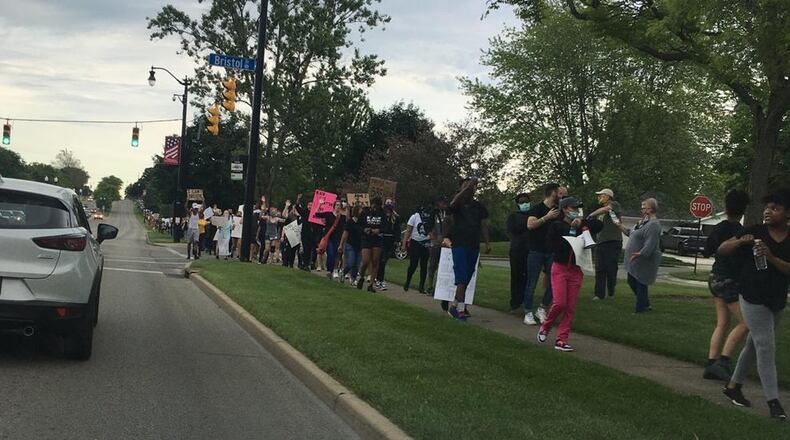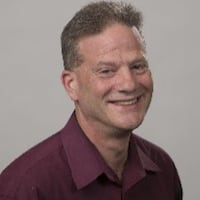During a Centerville vigil Monday night, leaders of the new Solution Movement group discussed goals with Centerville police, with officers later saying there is “mutual respect” between the organizations.
EARLIER: Dayton protests ends with dozens of arrests: What we know now
Tonight, Omega Baptist Church will host a 7 o’clock “community conversation” on Facebook Live, sharing discussion from seven local black leaders on next steps forward. Omega Pastor Joshua Ward said he doesn’t know the best answer, but he wants to bring together people who have been working on justice issues locally.
“The way forward is going to have to be a collaborative effort all throughout the community, and we’re trying to have that discussion,” Ward said. “What will it take to turn this from a moment of marching and protest into an effective movement for change?”
Floyd, who was black, died May 25 after a white Minneapolis police officer, knelt on his neck for nearly nine minutes while Floyd was handcuffed. That officer, Derek Chauvin, has been charged with third-degree murder and second-degree manslaughter. He and three other officers at the scene were fired from the police department.
The widespread protests after Floyd’s death — coming three months after the high-profile deaths of Breonna Taylor in Louisville and Ahmaud Arbery in Georgia — spur memories of 2014.
In a span of less than six months that year, Eric Garner, Laquan McDonald, Michael Brown, Tamir Rice and John Crawford were killed by officers. Police departments paid out million-dollar-plus settlements in each case, and an officer was convicted of murder in the McDonald case, but Ward acknowledged many of the concerns remain.
POPULAR: Historic downtown landmarks, businesses damaged in protest unrest
“We know there are a whole lot of issues and situations. Right now we’re trying to figure out how do we get people to stop killing us,” he said. He said the George Floyd death has created some different momentum because of the video.
“There are a lot of folks who often would be in the camp of ‘let’s wait until all the facts come out, we don’t know what happened,’ ” Ward said. “But I’m seeing this across racial lines and religious lines, so many traditional dividing lines — a lot of folks are just saying, ‘This is wrong, and we do have a problem, so what do we need to do?’ “
The Solution Movement had more than 500 peaceful protesters in Centerville on Monday night, and wants an active role in educating local leaders and law enforcement about racial concerns.
Executive Director Asia Gibbs said the group plans to work with Centerville police “to do some community engagement and start the conversation about keeping black and brown Americans safe in their jurisdiction – and hopefully – help spark that in other jurisdictions as well.”
Gibbs, a Dayton resident and Trotwood-Madison High School graduate, cited goals of eliminating profiling and racism within police forces, getting better diversity training for police officers and creating a safe, healing space for black and brown people.
The group talked with Centerville police before and after its protest, which was held at Stubbs Park and Spring Valley Pike near the police headquarters, said John Davis, the department’s public information officer.
RELATED: Dayton area church leaders: Protestors’ voices not being heard
“There was mutual respect for each other, which was easy to establish since our goals were the same,” Davis said in an email. “Everyone wants what is best for our community.”
Gibbs said her organization are looking into holding monthly forums to create a safe place for citizens and officers, and government officials to talk about what’s going on.
“We’re not going to allow this issue to die again,” she said.
At the Beavercreek protest, Alexandra Scott also said she felt weary from years of deaths, and eager to see changes.
“We’re tired, we’ve been tired … it’s too much,” she said. “So we wanted to do something, to just be here and show this needs to stop, things need to change – yesterday.”
Some Beavercreek police officers knelt in solidarity with the crowd, and police officers later stepped up to the curb and talked with several protesters.
Greene County resident Laqueta Maze said she felt emotional when she saw police kneeling.
“The police chief should want this; he should want communication in the community to be strong, and that’s what’s going to make it happen,” Maze said. “We are all standing against injustice, period.”
A Fairborn officer taking photos with protesters was heard saying, “We’re all one.”
But comments from some police and black residents this week show there are significant relationship gaps.
There have been models proposed for improvement before, including the Campaign Zero proposals aimed at reducing police violence. And Dayton Police Chief Richard Biehl touted Cincinnati's Collaborative Agreement of almost 20 years ago as "a very good template for changing the dialogue and relationship between police and the community that they serve."
Gibbs said she hopes a new conversation can prevent some of the damage of the past week and get people invested in their communities. Ward agreed.
“My prayer is that the discussion is fruitful, that it’s helpful to folks,” Ward said. “We’re trying to come out with some very real, feasible action steps that people can take.”



